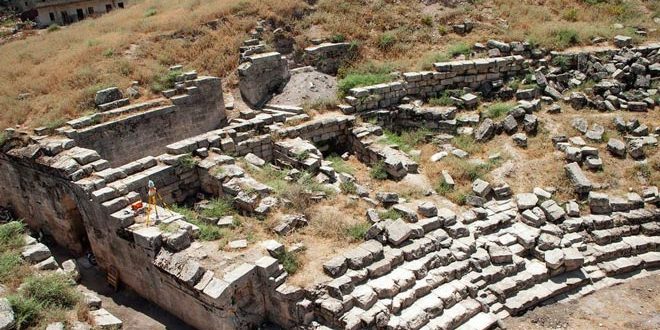The Roman theater at Apamea is considered one of the largest theaters built by the Romans and remained the largest extant Roman edifice of its type that has survived the ravages of time.
It is estimated to have held audiences of over 25,000 spectators, and only the theater of Pompey in Rome surpassed it in size.
This archaeological edifice was distinguished by the sound propagation technique used in it, so that everything that was going on the stage could be heard from any side in the theater, which made it a matter of astonishment, admiration and research by contemporary specialists.
The theater is located in the ancient city of Apamea at its western edge at the opposite foot of the Al-Madiq Castle in the Hama countryside.
Although it was built in the Roman period, it was designed in the Hellenistic style, as it was made use of during its construction from the bending of the earth to support it.
Today, the theater as a whole is not well preserved. It was used as a square and a quarry for the restoration of the Al-Madiq Castle in the time of Nur Eddin al- Zangi in the 12th century AD.
When the Ottoman Sultan Suleiman the Magnificent built a khan in the city in 1531, its stones were removed from the rubble of the theater, and many lime kilns were found that were used for the manufacture of lime. All of this contributed to the sabotage and destruction of this edifice during the Middle Ages.
Regarding the date of building the Apamea Theater, the archaeological researcher, Dr. Bassam Jamous, believed that it dates back to the second century AD, and its plan reminds us of the Aspendos Theater in Antalya, pointing out that there are some walls and foundations dating back to the Hellenistic period and located under the theater amphitheater.
The archaeologist added that the theater consists of a facade of 139 meters in width, of which only a few bricks remain, and a small part, about 8 meters high, decorated with square Corinthian capitals
Dr.Jamous pointed out that the theater had a semi-circular shape centered with the stands, and connected with them to the corridors and staircases that met at the upper lobby, in addition to a staircase that allowed access to the entrance to the huge southern theater.
As for the theater orchestra, it is a semi-circular arena located at the bottom of the stands. It contains the remains of stone tiles.
Excavations and archaeological research have begun to discover the Apamea theater, according to Jamous, since the beginning of the sixties of the last century by the Belgian archaeological mission.
The archaeological researcher affirmed that what affected the current state of the theater that it turned into a fortress in the Middle Ages, where in that period a square tower was built on one of the entrances to its western facade, and another circular tower was built on top of the amphitheater to the west as well, and all the corridors leading to the theater were blocked.
Due to the use of the theater in the later Islamic eras, artifacts dating back to those eras were found, such as pottery.
During the excavations works of the Belgian archaeological mission, the main entrance , which is located in the center of the theater, was liberated.
During its excavation operations for the years 2008-2009-2010 ,the joint Syrian-American archaeological mission cleaned and liberated the main entrances and corridors of the theater and removed stone blocks that used to block the paths.
Dr. Jamous referred to the major project which the General Directorate of Antiquities and Museums ( GDAM) started in 2009 in cooperation with American experts to restore the theater.
The project included an engineering elevation and a topographic survey of the building in order to revive this important archaeological edifice, but the war on Syria and the prolonged attacks on the Apamea site and its theater by terrorist organizations prevented the accomplishment of this project.
Rawaa Ghanam

